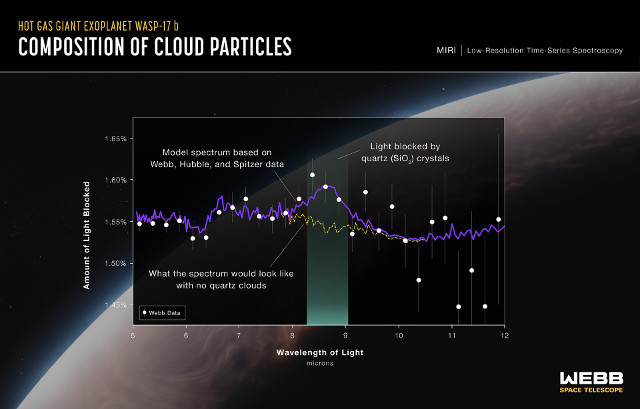
An article published in “The Astrophysical Journal Letters” reports a study of the exoplanet WASP-17 b that includes the detection of quartz in this hot Jupiter’s atmosphere. A team of researchers used the James Webb Space Telescope to detect the subtle effects of quartz crystals, nanoparticles dispersed in the very hot atmosphere of WASP-17 b, which received the official name Ditsö̀ in early 2020.
The image (Illustration: NASA, ESA, CSA, Ralf Crawford (STScI). Science: David Grant (University of Bristol), Hannah R. Wakeford (University of Bristol), Nikole Lewis (Cornell University)) shows an artistic illustration of the exoplanet Ditsö and the spectroscopic detections obtained using the James Webb Space Telescope’s Mid-Infrared Instrument (MIRI) obtained in 10 hours of observations. The purple line is the best-fitting model to explain the data obtained, including data from the Hubble and Spitzer space telescopes. The yellow dotted line indicates what the spectroscopy would look like if Ditsö’s clouds did not contain quartz.
About 1,300 light years away from Earth, the exoplanet Ditsö orbits around a star, which received the official name Dìwö, a little larger and more massive than the Sun. Ditsö’s year lasts only about 3.7 Earth days, and this means that it’s very close to its star and its atmosphere is extremely hot, around 1,500° Celsius, hence being part of the class of hot Jupiters. For this reason, a planet with a mass that is about half that of Jupiter is almost twice the size of Jupiter.
The extreme conditions existing in the atmosphere of the exoplanet Ditsö are decisive for the formation of quartz nanoparticles. Understanding the composition of the atmosphere and detecting the possible presence of clouds is crucial to fully understand the nature of a planet. The exoplanet Ditsö was one of the targets of the JWST Telescope Scientist Team’s (TST) Deep Reconnaissance of Exoplanet Atmospheres using Multi-instrument Spectroscopy (DREAMS) investigation along with a warm Neptune and a temperate rocky planet.
The discovery of the exoplanet Ditsö was announced in 2009 and several studies have already been conducted on it. The Hubble Space Telescope offered detections of aerosols in its atmosphere. Other observations were conducted with the Spitzer Space Telescope. However, it took the James Webb Space Telescope and in particular its MIRI instrument to obtain, through the transmission spectroscopy technique, the necessary measurements to identify the presence of quartz particles that have a size of around 10 nanometers.
Silicates were already detected in the atmospheres of exoplanets and brown dwarfs but these are usually compounds that include magnesium such as olivines and pyroxenes. The signatures detected on the exoplanet Ditsö are the first to indicate the presence of quartz. In this case, the detections were possible thanks to the passage of Ditsö in front of its star and this can also be done with other exoplanets of the hot Jupiter class.

